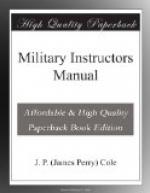Trenches. What is position in readiness?
Troops placed in readiness for action where it is intended to resist the advance of enemy in immediate vicinity, but knowledge of his movements not yet sufficiently definite to decide upon plan of action. Preliminary to taking up offensive, or more usually to taking up and occupying defensive position. Hasten deployment when time comes.
18. If it becomes necessary to withdraw troops from action state steps necessary to insure the safety of troops during the withdrawal and retreat.
Ans.—Last reserves should be used. If none, troops least pressed used to cover withdrawal. Cavalry and artillery used unsparingly. Depends on the terrain. First covering position well to the rear so as not to suffer demoralization. On flanks of line of retreat. There should also be facilities to withdraw the occupying force. Firing line made as strong as possible, minimum of reserves held. Use M.G. Perhaps successive covering points necessary further to rear before advance of enemy can be checked. When a few miles to the rear, or far enough to free troops from all contact with the enemy, reorganize. Step-by-step opposition useless. Number of covering positions should be reduced to the minimum.
Retreat; trains at once put into march. Other forces at once put into order of march. All roads used, separate roads for divisions.
Effective rear guard from troops whose strength and morale is least impaired.
Divisional cavalry and as much artillery as can effectively be used. Use artillery at long range to keep the enemy deployed, destroy bridges, etc.
CHAPTER 9.
Feeding Men.
IN CAMP.—You will usually have plenty of food but continual inspecting is necessary to have it properly cared for, prepared and served. The kitchen must be kept clean: company commanders inspect daily and insist on the following:
1. Have cooks and enlisted
men come to attention at the command of
the first man who sees you approach.
2. Have all refrigerators opened,
and put your head in far enough
to detect any bad odors.
3. Check the bill of fare and
see that food not consumed one day is
utilized later—waste bread for bread pudding,
for example.
4. See that doors close properly,
that windows are screened and roof
is tight—allow no flies.
5. Have floors, tables and
refrigerators scrubbed daily.
6. Have the ground around the
mess shack raked and thoroughly
policed. Towels hung out to dry must be so hung
as not to fall to the ground. Raked ground does
not allow flies to build undisturbed.
7. Taste the coffee and look
in the coffee bins.
8. Inspect pans, knives, meat
grinder (have latter taken apart for
you occasionally).
9. See that the mess sergeant
looks after the incinerator properly;




